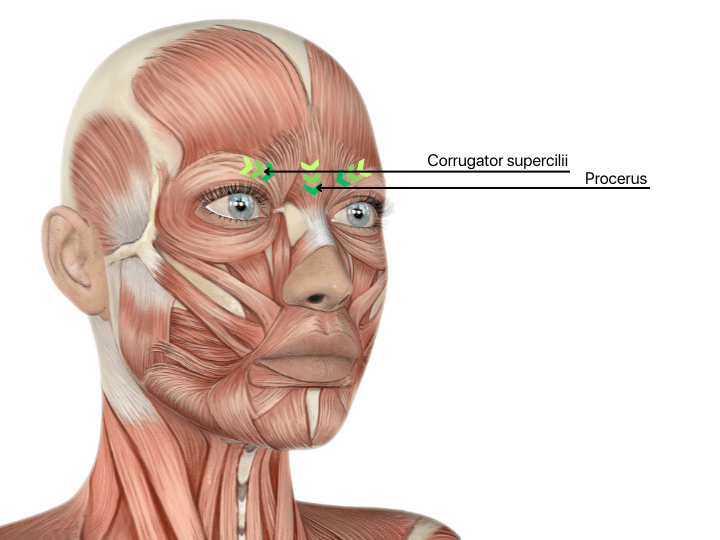Frown Lines Treatment Melbourne
Frown lines in the glabella may appear in our thirties or earlier and then continue to form with the ageing process.
Consultations with a doctor are available to assess and discuss the various treatment options for frown lines.
What are frown lines?
Frown lines are a type of dynamic wrinkle that forms in the glabella, the area between our eyebrows, due to the repeated movement of our facial muscles when we frown or make facial expressions. Lines can also appear across the forehead, on the bridge of the nose and at the corners of the eyes.
Frowning is a facial expression that may convey the negative expression of anger, stress or concern. In fact, the Merriam-Webster dictionary defines ‘frown’ as “to contract the brow in displeasure or concentration” and “to give evidence of displeasure or disapproval by or as if by facial expression”.
What causes frown lines?
Frown lines are caused by the repeated action of our facial muscles when we squint or frown. These facial lines often deepen and become static when we get older because our skin loses elasticity. People who wear glasses may experience more prominent frown and forehead lines because they squint more often, particularly when not wearing their glasses.
Two primary muscles are responsible for frowning: the corrugator supercilii and the procerus muscles. The corrugator supercilii muscle runs along the length of the eyebrows and pulls them together, creating vertical lines between the brows. Frequent or intense frowning can make these lines more permanent. The procerus muscle, located vertically between the brows, causes the skin to bunch up and form a horizontal line across the bridge of the nose when contracted. Overuse of this muscle can lead to a permanent etched line in that area.
Other environmental and lifestyle factors may also contribute to the development of frown lines, including:
- Sun exposure
- Skin dehydration
- Smoking
- Excessive consumption of alcohol
- Stress

How do you treat frown lines?
- A consultation with a doctor is required, where a detailed medical history and examination are made.
- The facial skin is examined. Skin laxity, volume loss, texture, and expression lines are assessed.
- Standardised clinical photos and videos of the face are taken, and a Visia skin analysis is performed.
- A plan, including costs, is provided, and adequate time is allowed to pass (cooling-off period) before the treatment plan commences.
- An explanation of the proposed treatment is made.
- The risks and benefits of the proposed treatment are explained, and a consent form is completed before the treatment commences.
Consultations for frown treatment are available with our doctors at our Lower Templestowe and Berwick clinics.
What can I expect during frown line treatment?
When you arrive for your appointment, your face will be cleansed, and clinical photographs and videos will be taken for your medical file. You will also undergo a VISIA skin analysis scan to objectively measure your baseline before treatment. Your doctor will then reassess your frown lines, discuss the treatment plan, and confirm the costs.
After the treatment is complete, we recommend scheduling a follow-up appointment with your doctor two to four weeks later.
How do I care for my skin after frown line treatment?
Studies have shown that using skincare containing Vitamin A and Vitamin C can reduce visible signs of skin ageing. Additionally, regular use of sunscreen can delay skin ageing in healthy males and females.
FAQ
Can you get rid of frown lines forever?
Frown line treatments are not permanent, and repeat sessions will be necessary to maintain results. The number of treatments needed and the time between them can vary for each patient. However, we typically recommend having treatments three to four times per year initially.
How much do frown treatments cost?
The cost of your frown treatment will be discussed during your consultation, during which you will be provided a written quote. The price will depend on the specific treatment your doctor prescribes and the severity of your lines.
What are the risks and side effects of frown line treatment?
All frown line treatments carry risks and potential side effects, which may be temporary or last several months. These can include bruising, redness, swelling, infection, eyelid drooping (ptosis), and an undesirable cosmetic outcome, such as a lack of response to the treatment or over-treatment.
Why choose Victorian Cosmetic Institute to treat your frown lines?
Since 2005 the doctors at Victorian Cosmetic Institute have performed frown lines treatment in Melbourne. During your initial consultation, the doctors take the time to assess your concerns, your suitability for treatment and discuss your treatment preferences and expectations. Photos are taken at every appointment to ensure your treatment is working as expected.
Call our Customer Care team on 1300 863 824 to arrange your consultation. Alternatively, you can book your consultation online.
Last updated December 2024
